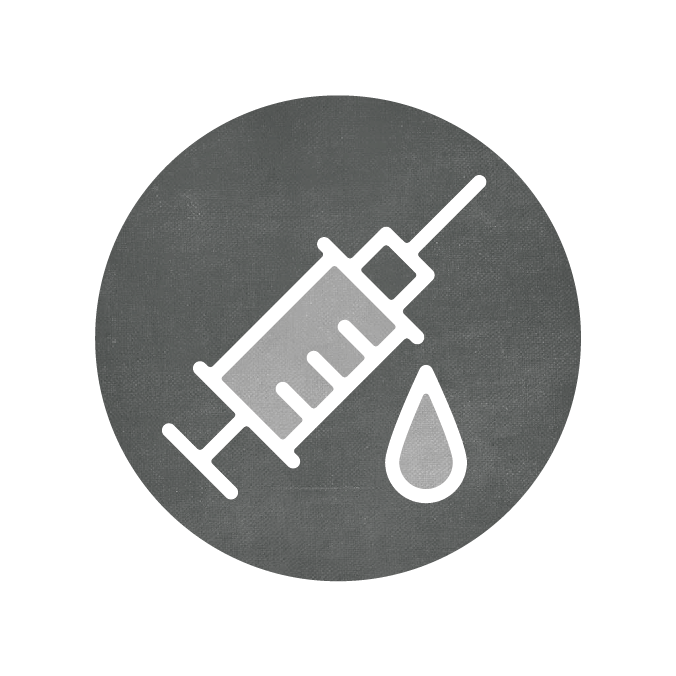How Nutrition and Physical Activity Impacts Health
Nutrition and physical activity are the foundations of good health. Proper nutrition provides essential nutrients for bodily functions, supporting growth, repair, and immunity. Regular physical activity strengthens muscles and bones, improves cardiovascular health, and can reduce symptoms of depression1. Combined, nutrition and physical activity help maintain a healthy body weight and reduce the risk of chronic conditions like diabetes and heart disease. Many factors, such as income and access to safe recreational spaces and healthy foods, impact the ability to maintain proper nutrition and engage in regular physical activity.
Adult Physical Activity
Why this is important: There are many health benefits to being physically active and reducing sedentary behavior. Participating in the minimum recommended aerobic and strength training activities reduces the risk of many chronic diseases, improves overall health and fitness, and prevents adverse health outcomes and early death. Physical fitness and activity are essential for healthy aging and performing routine daily activities allowing for the energy to enjoy hobbies, leisure time, and overall positive well-being and quality of life.
Definition: Percent of adults who report physical activity or exercise in the last 30 days other than regular job

Trend: Since 2019, the percent of adults in Whatcom County that report physical activity or exercise in the last 30 days increased significantly, and this number continues to trend upward.

Geography: In 2022, the percent of adults in Whatcom County that report physical activity or exercise other than their regular job in the past 30 days is similar to that across Washington State.

Disparities: In 2022, among adults who report physical activity or exercise other than their regular job in the past 30 days, there is evidence of disparities for age group and racial group.
Learn more:
- Whatcom County Parks and Recreation
- Whatcom Family YMCA
- Physical Activity Guidelines for Americans, US Department of Health and Human Services, 2018.
- Physical Activity for Adults: An Overview, Centers for Disease Control and Prevention.
- What You Can Do to Meet Physical Activity Recommendations, Centers for Disease Control and Prevention.
Adult Meeting Physical Activity Guidelines
Why this is important: Meeting physical activity guidelines is important for reducing the risk of chronic diseases, enhancing overall health, and improving quality of life. Regular exercise helps maintain physical fitness, supports healthy aging, and enables adults to perform daily activities with ease and energy, contributing to overall well-being and longevity.
Definition: Percent of adults who participated in enough Aerobic and Muscle Strengthening exercises to meet guidelines (150 min/week, 2 days of strengthening)

Trend: Since 2011, there has been no significant change in the percent of adults who report both aerobic and strength physical activity that meet recommended guidelines. However, the percentage of adults who report activity to meet recommended guidelines in Whatcom County increased by 17% between 2017 and 2019.

Geography: The percent of adults who report aerobic and strength physical activity that meet recommended guidelines is similar to that across Washington State.

Disparities: Among the adults from Whatcom County who reported aerobic and strength physical activity that meet recommended guidelines over three survey years (2015, 2017, 2019), no disparities are observed.
Adult Fruits and Vegetable Intake
Why this is important: Fruit and vegetable intake is vital as they are rich in nutrients, antioxidants, and fiber, essential for maintaining overall health. Making fruits and vegetables a regular part of the diet supports optimal immune function, aids in weight management, and reduces the risk of chronic diseases such as heart disease, stroke, and certain cancers. The standard recommendation is for adults to consume fruits and vegetables at least five times a day2.
Definition: Percent of adults who report eating fruits and vegetables 5 or more times per day

Trend: The percent of adults who report eating fruits and vegetables 5 or more times per day in Whatcom County is decreasing slightly between 2015-2021. However there have been no significant changes during this time.

Geography: The percent of adults who report eating fruits and vegetables 5 or more times per day in Whatcom County is similar to that across Washington State.

Disparities: Among the adults in Whatcom County who report eating fruits and vegetables 5 or more times per day, there is evidence of a disparity for sex at birth.
Learn more:
- Washington Food and Farm Finder, Eat Local First.
- Food Access at Farmers Markets, WA State Farmers Market Association.
- SNAP/EBT Market Match, WA State Department of Health.
- Senior Farmers Market Nutrition Program, WA Department of Social and Health Services.
- Dietary Guidelines for Americans, US Department of Health and Human Services.
- How to Eat More Fruit and Vegetables, American Heart Association.
Youth Physical Activity
Why this is important: Being physically active is one of the most crucial actions people of all ages can take to improve and maintain their health. Physical activity improves cognition and academic performance among youth, helping them be successful in school3. Youth who regularly exercise are more likely to continue to be physically active into adulthood4 developing and maintaining good bone health, aerobic and muscular fitness, and healthy body weight. The Healthy People 2030 national target is 30.6% (grades 9-12).
Definition: Percent of 10th graders who report physical activity 60 minutes a day, 5 or more days a week

Trend: Between 2012-18, the percent of 10th grade students in Whatcom County who reported physical activity 60 minutes a day, 5 or more days a week showed no significant change. During the COVID-19 Pandemic, was reported above 55%. Caution should be used when interpreting 2021 survey data until further data is available.

Geography: In 2021, the percent of 10th grade students who report physical activity 60 minutes a day, 5 or more days a week in Whatcom County is significantly higher than that of Washington State.

Disparities: Among 10th grade students who report physical activity 60 minutes a day, 5 or more days a week in Whatcom County, disparities exist for gender identity, sexual orientation, and racial group. Hover over the data in the subpopulation tabs to discover more.
Learn more:
- Whatcom County Parks and Recreation
- Whatcom Family YMCA
- How Can I Help My Child Be More Physically Active? American Heart Association.
- Physical Activity Guidelines for Americans, US Department of Health and Human Services, 2018.
Youth Fruits and Vegetable Intake
Why this is important: Fruit and vegetable intake for youth is crucial as they provide essential vitamins, minerals, and fiber necessary for physical and cognitive growth and development. Incorporating fruits and vegetables into their diet supports immune function, cognitive development, and healthy digestion. Establishing the habits of eating fruits and vegetables early in life lays the foundation for lifelong healthy eating patterns, contributing to health throughout adulthood5. Children and youth may have fewer choices regarding eating fruits and vegetables, especially if availability is limited due to family eating patterns and/or food insecurity.
Definition: Percent of 10th grade students who report eating 5 or more fruits and vegetables per day

Trend: The percent of 10th grade students who report consuming 5 or more fruits and vegetables per day in Whatcom County was slowly decreasing between 2012-18, falling below 20% in 2018. During the COVID-19 Pandemic the percentage rose to nearly 23%.

Geography: Since 2012, the percent of 10th grade students in Whatcom County who report consuming 5 or more fruits and vegetables per day is similar to that across Washington State.

Disparities: Among 10th grade students in Whatcom County who report consuming 5 or more vegetables per day, a disparity was found for gender identity. Hover over the data in the subpopulation tabs to discover more.
Learn more:
- Whatcom Farm to School
- Common Threads
- Dietary Guidelines for Americans, US Department of Health and Human Services.
Food Access and Security
Food access and security are closely tied to income and poverty. People with lower incomes often struggle to afford nutritious food, which can lead to food insecurity. In many cases, poverty can limit access to grocery stores with fresh and affordable produce, forcing people to rely on less healthy, processed options. Addressing income inequality and providing support for those in poverty is essential to improving food access and ensuring that everyone has the opportunity to eat well and stay healthy.
Food Insecurity among Adults
Why this is important: Food insecurity refers to the inability to obtain enough healthy food due to limited income, the absence of grocery stores in close proximity, lack of transportation, or other factors. Food insecurity can cause family stress and anxiety and limit the amount, quality, and variety of foods people can obtain.
Definition: Percent of adults who report that food recently purchased did not last and they did not have money to buy more over the past 12 months

Trend: Since the question was first introduced in 2019, the percent of adults who report a recent food purchase did not last and they were without money to buy more has decreased significantly in Whatcom County. However, between 2021 and 2022 there was a smaller decrease of 13%.

Geography: There is no difference between the number of adults in Whatcom County reporting difficulty obtaining food compared to that of Washington State for the most recent three survey years.

Disparities: Among adults in Whatcom County who report a recent food purchase did not last and they were without money to buy more, evidence of disparities are found for age group and racial group. Hover over the data in the subpopulation tabs to discover more.
Learn more:
- Whatcom Food and Meal Guide, Opportunity Council.
- Food Insecurity Literature Summary, Healthy People 2030.
Food Insecurity among Youth
Why this is important: Access to enough nutritious food helps ensure appropriate physical and cognitive growth and development in youth, allowing them to learn effectively and reach their full potential. In addition to the nutritional benefits of adequate healthy food, food security helps young people by reducing the household’s stress and anxiety.
Definition: Percent of 10th grade students who report having to skip or cut the size of a meal in the last year because there wasn’t enough money for food

Trend: Between 2014-18, the number of 10th grade students reporting the need to cut meal size or skip a meal in Whatcom County showed no change. During the COVID-19 pandemic in 2021, this percentage decreased. Caution should be used when interpreting 2021 survey data until further data is available.

Geography: In 2021, there was no significant difference in the percentage of youth who experienced food insecurity between Whatcom County and Washington State.

Disparities: In 2021, disparities are observed for youth from different sexual orientations and among youth from different racial groups. Hover over the data in the subpopulation tabs to discover more.
Learn more:
- Whatcom Food and Meal Guide, Opportunity Council.
- Addressing Teen Hunger, Feeding America, 2021.
- Facts About Child Hunger in America, No Kid Hungry.
- Strategies to Improve Adolescent Food Security from the Perspectives of Policy Advocates, Parents, and Adolescents, Nutrients, 2022.
Supplemental Nutrition Assistance Program (SNAP) Benefit Recipients
Why this is important: The Federal Supplemental Nutrition Assistance Program (SNAP, formerly known as “food stamps”) helps lower-income households afford enough food and reduces food insecurity. Adults whose families had SNAP when they were children report better overall health, lower rates of heart disease and obesity, and spending less on healthcare6. During the COVID-19 pandemic, expanding SNAP eligibility played a crucial role in preventing increased hunger in at-risk populations.
Definition: Percent of households receiving Supplemental Nutrition Assistance Program (SNAP) benefits

Trend: There has been a significant decline in percent of households receiving SNAP benefits in Whatcom County from 2014 to 2023.

Geography: In 2023, there was not a significant difference in the percent of households receiving SNAP benefits between Whatcom County and Washington State.

Disparities: Disparities in SNAP benefit recipients in Whatcom County exist among race/ethnicity of householders, whether or not a person in the household has a disability, and household type. Hover over the data in the subpopulation tabs to discover more.
Learn more:
- Basic Food and Supplemental Nutrition Assistance Program (SNAP), Whatcom Asset Building Coalition.
- Washington SNAP-Ed
- SNAP Is Linked With Improved Health Outcomes and Lower Health Care Costs, Center on Budget and Policy Priorities, 2022.
- Supplemental Nutrition Assistance Program as a health intervention, Current Opinion in Pediatrics, 2023.
Children Eligible for Free or Reduced Lunch
Why this is important: The National School Lunch Program (sometimes referred to as the “free and reduced lunch program”) ensures that students from lower-income homes have access to healthy meals at school. Access to free or lower-cost school meals contributes to students’ nutrition, overall health and development, and food security. Proper nutrition is also linked to better school performance7, contributing to a foundation for students to succeed in school and lead healthier lives in the future.
Definition: Percent of students enrolled in participating schools who are eligible for National School Lunch Program (free and reduced lunch)

Trend: The number of Whatcom County student who are eligible for free and reduced lunch has increased over recent years and continues to show an upward trend.

Geography: The number of students who are eligible for free and reduced lunch in Whatcom County was similar to that of Washington State overall.

Disparities: Differences exist for this indicator based on school districts within Whatcom County for the most recent year, 2022. Hover over the data in the subpopulation tabs to discover more.
Learn more:
- School Meals, WA Office of Public Instruction.
- National School Lunch Program, US Department of Agriculture.
- School Meals are Essential for Student Health and Learning, Food Research and Action Center, 2019.
- True Cost of Food: School Meals Case Study, Rockefeller Foundation, 2021.
Additional Resources
- Access to Parks and Public Elementary Schools Data, Centers for Disease Prevention and Control.
- Whatcom Community Food Assessment, Whatcom County Food System Committee, 2021.
- Whatcom County Food System Plan, Whatcom County Food System Committee, 2023.
- Whatcom Food Network.
How to cite information or data from this website: Citation Instructions





